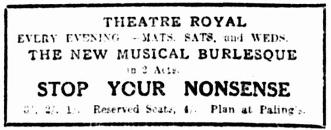
Latest Issues
AbstractHistoryArchive Description
The principal storyline concerns Dolly Gibbs, a spoilt rich girl who has run away and joined a theatre company so as to escape from Tommy Chester, a rich young ass who has been pestering her to marry him. Tommy tracks her down and they meet at the theatre, but only shortly before their respective parents arrive in hot pursuit. A secondary plot concerns the theatre company itself, and is said to spoof the American show business industry which manufactures mindless shows 'to meet the needs of its tired business men' (Age 20 December 1915, 9).
Stop Your Nonsense begins with the manager of the Highty Flighty Theatre (David Burlesko) telling the author of the play that is about to premiere that he has changed his mind and is now going in for vaudeville. "What about my beautiful play?" says the indignant playwright, Pinero Jones. "If it hadn't been for you I could have had it done by J. C. Williamson - or Harry Clay" (Theatre Magazine September 1915, p.12). The Bulletin's theatre critic proposes that what follows is not unlike the treatment a musical burlesque receives. It 'is generally understood to be the mere bleeding remnants of what its author originally produced. The nice new script is torn to pieces in rehearsal by stage staff and players; the mince is then mined and bombed after hours by author, producer and stage manager in collaboration; and finally the torn and teased and sundered thing is stuffed into a new sausage skin by all hands, including the musical director and the call boy' (19 August 1915, p.9).
[Source: Australian Variety Theatre Archive]
Notes
-
While the authorship of the libretto has not yet been positively identified, the Sydney Morning Herald attributes it to A. Riddik (12 August 1915, p.10), while the Bulletin records: "In so far as any one individual can be held responsible for Stop Your Nonsense… Beaumont Smith is rumoured to be the guilty party." The magazine's critic goes on to note, however: "He will neither affirm or deny [sic]; but if he is the sinner, he has struck the right mixture first try and fully deserves his own royalties (19 August 1915, p.9). It is likely that as director and producer, Smith contributed some material to the production.
Production Details
-
1915: Theatre Royal, Sydney; 14 August - 3 September.
- Director Beaumont Smith; Producer Beaumont Smith and Leslie Hoskins
- Troupe: Smith and Hoskins' Glad Eye Company.
- Cast: Tom Shelford (Tommy Chester), Ethel Dane (Dolly Gibbs), Henry J. Ford (David Burlesko), Frank Bradley (Lord Arrandale), Harry Sweeney (C. N. Shifter), Edward Landor (I. Makem), Frederick Hughes (E. C. Terms), Edmund Sherras (Pinero Jones), Fred Twitchin (Julius Lee Gitt), Bert Barton (Wildred Denver Jinks), Jack Kearns (Bill Gruff), Claude Vernon (Abraham Bloggs/Stage Manager), E. J. Vickery (Theophilus Budge), Percy Walsh (Parmenas Foss), Sinna St Clair (Mrs Obadiah Gibbs), Dorothy Hastings (Pearl Peerless), June Addell (A Flapper), Olga Agnew (Call Girl), Vera Kearns.
1915: King's Theatre, Melbourne; 18 December 1915 - 7 January 1916
- Director Beaumont Smith; Producer Beaumont Smith and Leslie Hoskins; Lessee Bert Bailey and Julius Grant.
- Troupe: Smith and Hoskins' Glad Eye Company.
- Cast: Tom Shelford (Tommy Chester), Irma Caron (Dolly Gibbs),Henry J. Ford, (David Burlesko), Frank Bradley (Lord Arrandale), Jack Kearns (Bill Gruff), Florence Fanning (Mrs Gibbs), Edmund Sherras (Pinero Jones), Edward Landor (I. Makem), Vera Kearns, Clarice Hardwick (Pearl Pearless), Millie Baker, Hilda McMutie, the Leteens.
This entry has been sourced from on-going historical research into Australian-written music theatre being conducted by Dr Clay Djubal.
Publication Details of Only Known VersionEarliest 2 Known Versions of
Works about this Work
-
'Stop Your Nonsense'
2005
2005
single work
criticism
— Appears in: Australian Variety Theatre Archive : Popular Culture Entertainment: 1850-1930 -
'Stop Your Nonsense'
1915
single work
review
— Appears in: The Theatre Magazine , September 1915; (p. 11-12)
— Review of Stop Your Nonsense 1915 single work musical theatre -
The Kings Theatre: 'Stop Your Nonsense'
1915
single work
review
— Appears in: The Argus , 20 December 1915; (p. 13)
— Review of Stop Your Nonsense 1915 single work musical theatre -
King's Theatre: 'Stop Your Nonsense'
1915
single work
review
— Appears in: The Age , 20 December 1915; (p. 9)
— Review of Stop Your Nonsense 1915 single work musical theatre
-
King's Theatre: 'Stop Your Nonsense'
1915
single work
review
— Appears in: The Age , 20 December 1915; (p. 9)
— Review of Stop Your Nonsense 1915 single work musical theatre -
'Stop Your Nonsense'
1915
single work
review
— Appears in: The Theatre Magazine , September 1915; (p. 11-12)
— Review of Stop Your Nonsense 1915 single work musical theatre -
The Kings Theatre: 'Stop Your Nonsense'
1915
single work
review
— Appears in: The Argus , 20 December 1915; (p. 13)
— Review of Stop Your Nonsense 1915 single work musical theatre -
'Stop Your Nonsense'
2005
2005
single work
criticism
— Appears in: Australian Variety Theatre Archive : Popular Culture Entertainment: 1850-1930


